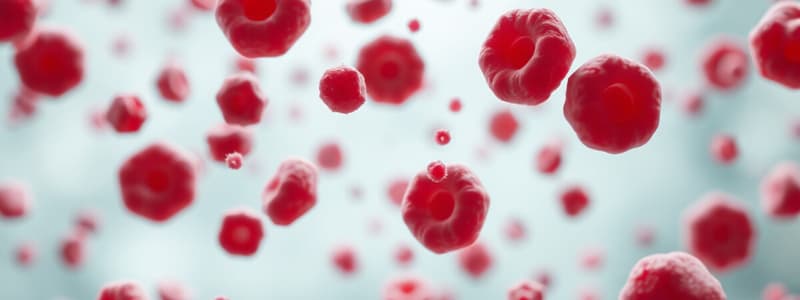Podcast
Questions and Answers
What defines aplastic anaemia?
What defines aplastic anaemia?
- Increased production of blood cells
- Pancytopenia resulting from aplasia of the bone marrow (correct)
- High levels of reticulocytes
- A type of leukemia
Which symptom is associated with thrombocytopenia in aplastic anaemia?
Which symptom is associated with thrombocytopenia in aplastic anaemia?
- High white blood cell count
- Red blood cell increase
- Easy bruising (correct)
- Elevated reticulocyte count
What is the primary laboratory finding in peripheral blood for a patient with aplastic anaemia?
What is the primary laboratory finding in peripheral blood for a patient with aplastic anaemia?
- Pancytopenia (correct)
- Elevated hematocrit levels
- Leukocytosis
- Increased reticulocyte count
Which of the following is NOT a cause of secondary acquired aplastic anaemia?
Which of the following is NOT a cause of secondary acquired aplastic anaemia?
What would you expect to find in a bone marrow biopsy of a patient with aplastic anaemia?
What would you expect to find in a bone marrow biopsy of a patient with aplastic anaemia?
What is a common infection complication seen in patients with aplastic anaemia?
What is a common infection complication seen in patients with aplastic anaemia?
Which supportive measure is critical in managing a patient with aplastic anaemia?
Which supportive measure is critical in managing a patient with aplastic anaemia?
Which drug is known to cause marrow depression leading to aplastic anaemia?
Which drug is known to cause marrow depression leading to aplastic anaemia?
What is the main goal of specific management in cases of aplastic anaemia?
What is the main goal of specific management in cases of aplastic anaemia?
What characterizes the reticulocyte count in aplastic anaemia?
What characterizes the reticulocyte count in aplastic anaemia?
Study Notes
Aplastic Anaemia Overview
- Aplastic anaemia (AA) leads to pancytopenia, characterized by decreased blood counts across all cell lines: red blood cells, white blood cells, and platelets.
- Aplasia refers to the replacement of active bone marrow with non-functioning fatty marrow.
Causes of Pancytopenia
- Pancytopenia can result from:
- Decreased bone marrow production (e.g., aplastic anaemia).
- Increased peripheral destruction (e.g., hypersplenism).
Classification of Aplastic Anaemia
- Congenital Aplastic Anaemia
- Acquired Aplastic Anaemia
- Primary (Idiopathic)
- Secondary, which includes:
- Cytotoxic drugs (e.g., Busulphan).
- Ionizing radiation (e.g., radiotherapy).
- Chemicals such as benzene.
- Drugs that may cause marrow depression (e.g., chloramphenicol).
- Viral infections, notably Epstein-Barr virus.
Clinical Features
- Symptoms reflect bone marrow failure:
- Features of anaemia (fatigue, pallor).
- Bleeding issues due to thrombocytopenia, such as:
- Bruising
- Bleeding gums
- Epistaxis (nosebleeds)
- Menorrhagia (heavy menstrual bleeding)
- Increased infections resulting from leucopenia, especially oral and throat infections.
- Typically, no organomegaly (enlargement of organs) is observed.
Investigations
- Complete Blood Count (CBC) Findings:
- Decreased hemoglobin (anaemia).
- Reduced white blood cells (leucopenia).
- Low platelet count (thrombocytopenia).
- Reticulocyte Count: Typically low.
- Peripheral Blood Film: Shows normochromic normocytic red blood cells.
- Bone Marrow Examination: Hypoplastic, with over 75% replacement of red marrow by fat.
Management Strategies
- General Measures:
- Identify and remove causative factors when possible.
- Implement supportive measures:
- Blood transfusions to correct anaemia.
- Platelet concentrates to manage thrombocytopenia.
- Treat existing infections or provide prophylactic antibiotics.
- Specific Management:
- Bone marrow transplantation (hematopoietic stem cell transplantation) is a critical treatment option.
- Some cases may experience spontaneous recovery without intervention.
Studying That Suits You
Use AI to generate personalized quizzes and flashcards to suit your learning preferences.
Description
This quiz covers the essential aspects of aplastic anaemia, including its definition, causes, and classification. Learn about the clinical features and how this condition impacts blood cell production. Test your knowledge on congenital and acquired forms of aplastic anaemia and their underlying factors.


